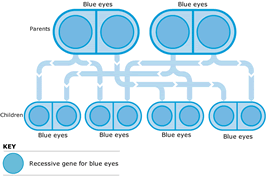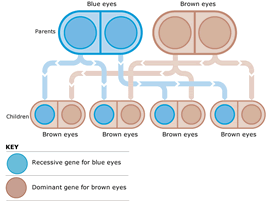Why are Sunsets Red?
 Why are most sunsets red? For exactly the same reason that the sky is blue. When the Sun is at the horizon, its rays have to travel through more atmosphere, and the green, blue, and violet light get scattered the most-filtered out of the light, basically. By the time the light reaches our eyes-and the clouds above us-it’s made up largely of yellow, orange, and especially red. That’s why the sky sometimes almost appears to be on fire at sunset and sunrise.
Why are most sunsets red? For exactly the same reason that the sky is blue. When the Sun is at the horizon, its rays have to travel through more atmosphere, and the green, blue, and violet light get scattered the most-filtered out of the light, basically. By the time the light reaches our eyes-and the clouds above us-it’s made up largely of yellow, orange, and especially red. That’s why the sky sometimes almost appears to be on fire at sunset and sunrise.
Cat’s Eye Nebula
 In 1786, high in the Northern Sky in the constellation Draco, William Herschel discovered a planetary nebula now known as the Cat’s Eye Nebula. It has become particulary well known today through the magnificent detailed images made by the Hubble Space Telescope. The nebula is quite young-around 1,000 years old-and, at about 3,300 light years from Earth, is only a small object in the night sky.
In 1786, high in the Northern Sky in the constellation Draco, William Herschel discovered a planetary nebula now known as the Cat’s Eye Nebula. It has become particulary well known today through the magnificent detailed images made by the Hubble Space Telescope. The nebula is quite young-around 1,000 years old-and, at about 3,300 light years from Earth, is only a small object in the night sky.
What makes the Cat’s Eye Nebula so fascinating is that it is surrounded by a series of faint concentric shells of gas, which may be material blown into space by the central star in an earlier phase of its life, at intervals of a few hundred to a couple of thousand years, but astronomers are still in the dark about the precise
causes. They do know, however, that the star sill has an enormously strong stellar wind, losing twenty billion tons of per second!
The central star is not a white dwarf, as with many other planetary nebulae, but a massive, hot Wolf-Rayet star, 10,000 times as luminous as the Sun and with a surface temperature of 80,000 Celsius. The Cat’s Eye Nebula proved to have more surprises in store. The American space telescope Chandra discovered that there is a source of
extremely high-energy X-rays at the center of the nebula. The radiation may be emitted by gas from the central star that is being captured by a companion and heated to high temperatures in the process. An invisible companion could also explain the complex structure of the nebula.
(Source: Deep Space by Govert Schilling
Does the 5 second rule work?
Does the 5 second rule work? Lets say your going to eat a banana and you drop it, I’m pretty sure most of us will pick it up and eat it. Some of us will use the 5 second rule others even the 10 second rule but does the 5 second rule work? In 2003 Jillian Clarke famously did a study on this subject and she found out that 50 percent of men use this rule to eat food off the ground and 70 percent of women use this the rule but more importantly she also found out that if any food has brief contact with the floor it gets contaminated wet or dry. A paper published by a Journal Applied microbiology got more in-depth, the researchers contaminated different floor surfaces with salmonella and they found out that 5 seconds contaminates it almost instantly but time can help. At 5 seconds they found out the food had collected wherever from 150 to 8000 bacteria but if it is left for a minute the number is 10 times greater. Knowing it only takes 10 bacteria of certain salmonella to effect you, you should reconsider eating food off the ground.
(source – http://news.aces.illinois.edu/news/if-you-drop-it-should-you-eat-it-scientists-weigh-5-second-rule )
(source- http://onlinelibrary.wiley.com/doi/10.1111/j.1365-2672.2006.03171.x/full )
Schrodinger’s Cat
 Some of us may have heard of Schrodinger’s cat but do you know what it is, if you do great! And if you don’t I’ll explain it for you. In 1935, Austrian physicist Erwin Schrodinger published an article on this extraordinary paradox with consequences that are so striking that it continues to mystify and concern scientist to this day.
Some of us may have heard of Schrodinger’s cat but do you know what it is, if you do great! And if you don’t I’ll explain it for you. In 1935, Austrian physicist Erwin Schrodinger published an article on this extraordinary paradox with consequences that are so striking that it continues to mystify and concern scientist to this day.
Schrodinger had been upset about the recently proposed Copenhagen interpretation of quantum mechanics that stated, in essence, that quantum system exist as a cloud of probability until an observation is made. At a higher level, it seemed to suggest that it is meaningless to ask precisely what atoms and particles were doing when unobserved; in some sense, reality is created by the observer but before being observed, the system takes on all possibilities. What could this mean for our everyday lives? Imagine that a live cat is placed in a box with a Radioactive source, a Geiger Counter, and sealed glass flask containing deadly poison. When a radioactive decay event occurs, the Geiger counter measures the event, triggering a mechanism that releases the hammer that shatters the flask and releases the hammer that shatters the flask and releases the poison that kills the cat. Imagine that quantum theory predicts predicts a 50 percent probability that one decay particle is emitted each hour. After an hour, there is an equal probability that the cat is alive or dead. According to some flavors of the Copenhagen interpretation, the cat seemed to be both alive and dead – a mixture of two states that is called a superposition of states. Some theorists suggested that if you open the box, the very act of observation “collapses the superposition” making the cat either alive or dead.
Schrodinger said that his experiment demonstrated the invalidity of the Copenhagen interpretation, and Albert Einstein agreed. Many questions spun from this thought experiment: What is considered to be a valid observer? The Geiger counter? A fly? Could the cat observe itself and so collapse its own state? What does the experiment really say about the nature of reality?
Some references were taken from ‘The Physics Book’ by Clifford Pickover
Why radiation is not as bad as we think…
Now that we went over these forms of radiation and we know that radiation is helpful and used in your everyday life. Now we know there’s radiation but we never really went over what is radiation if simply put radiation is the release of energy in the form of moving waves or streams of particles this energy can be low-level like the ones I went over or high level like x-ray or cosmic rays from outer space these are known as non-ionizing which are the non-hurtful radiation and ionizing which is damaging but if we really want understand radiation we need to look at an unstable atom. For an atom to be unstable it needs to few neutrons or to many neutrons when this happens it becomes unstable or radioactive an unstable atom is called a radioisotope. Radioisotopes want to become stable again so they release energy until they get back to a balanced state but this process is known as radioactive decay and there is three main types alpha, beta and gamma. Alpha particles are heavy and travel small distances, beta particles are lighter and travel further and there’s gamma which I’m pretty sure almost every Marvel fan knows this is what turned Bruce Banner into the Hulk sadly that wont ever happen but back to gamma, gamma is an actually a wave and is the lightest of them all so it travels the furthest of them all.
This paragraph is about background radiation and dosages. Ionizing radiation is measured in sieverts so I’ll be telling you how much radiation is too much and what has radiation in it. Geiger counters measure in sieverts and that’s the unit I’ll be using to explain dosages there’s also another unit and its called rem and this is what America uses as there unit to measure radiation but that’s not my preferable unit. If your exposed to more than two sieverts all at once, your chances at living aren’t that great and maybe two sieverts seems like not that much but that’s a lot. I’m pretty sure almost everyone has eaten a banana, they’re rich in potassium and some of that potassium is naturally radioactive. They have 0.1 microsieverts that’s one ten millionth of a sievert so because we eat bananas we actually become radioactive. Actually you are exposed to more radiation if you sleep next to someone then if you sleep alone. I wouldn’t worry about that because that dose is insignificant compared to the natural background radiation of earth I mean ionzing-radiation coming out of the soil and the rocks and the air, even from space. The average ionzing-radiation globally is around 0.2 microsieverts and its lower and higher in different places like Chernobyl and Fukushima where there was nuclear accidents. Your yearly dose of background radiation is about 2,000 microsieverts and if you were to get one chest ct scan you’ll receive 7,000 microsieverts that’s three years worth of background radiation. US radiation workers are limited to 50,000 microsieverts but that’s less than other occupation, astronauts an astronaut on the space station for six months will receive about 80,000 microsieverts worth of radiation, But not even they are exposed to the highest level of ionizing-radiation, The answer is a smokers lungs. A smokers lungs on average will receive 160,000 microsieverts worth of ionizing-radiation every year that’s do to the radioactive polonium and radioactive led in the tobacco there smoking, so not only are the exposed to toxins they will receive very high levels of ionizing-radiation. So if you thought smoking was bad, now here’s a whole other reason not
to smoke.
How the Eye Works and the Flaws in It.
Don’t get me wrong the human eye is great but there is some flaws in it like, Angle Closure Glaucoma, Macular Degeneration, Detached Retina, and is very susceptible to disease. The human eye does not have that bad of vision compared to other animals out there for example like a skunk they have horrible vision.
What is the structure of the eye? The eye is shaped by the scelera which is the muscles attachment. Ever get blinded by incoming light and then finally able to see after a movie? Well, it is a group effort that allows you to regulate and see. Part of that job is the cornea that refracts the light and the retina is what focuses on the light while the iris regulates the amount of incoming light while the pupil admits the light. The lens are what refracts and focus on the light rays and the Ciliary Body is what holds the lens in place and changes the shape of the lens to help focus. Viterous humor maintains the intracular pressure while transmitting light to the retina and keeps the retina firmly pressed against choroids. Optic Nerves is what transmits impulses to the brain. Choroid is responsible for the absorbtion of strays of light and nourishes the retina.
How do photoreceptors work? Photoreceptors contain chemicals that change when they are hit by light. This causes an electrical signal, which is then sent to the brain along the optic nerve. Different types of photoreceptor allow us to see an enormous range of light: from starlight to full sunshine, and all the colors of the rainbow. We see because we have three photoreceptors, but the animal with the most receptors is sixteen, so what orange to us may be different to an animal that has sixteen. We see what we see because of the three photorecepors that we have that see in red, blue, and green. Though it doesn’t compare to birds who have four photoreceptors that see ultraviolet (UV) as well as red, blue, and green.
How does the eye work? When you look at an object, the light from it enters your eye through the pupil. The iris changes the size of the pupil, depending on how bright the light is. The lens focuses the light onto the back of the eye: the retina. The retina is a mass of light-sensitive neurons, called photoreceptors, which change light signals into electrical ones.
Do humans really see in color? Well, there are two possible answers to this question. First one is how you define ‘colors’. The color of visible light is spread out in the rainbow of the color prism which are a section of the spectrum of electromagnetic radiation. The opposite end of this section are infrared and ultraviolet light, that are invisible to the human eye but some animals are known to detect these. Though these are invisible to the human eye one might not call these “colors” in the sense that you can not see them with the naked eye. So, depending on how you view this, the answer is completely up to you.
There are many wavelengths in the electromagnetic spectrum the human eye cannot detect. We can’t see them because our eyes are not made to see them directly, insects can see other parts of the spectrum of light we can’t. For example, bees and butterflies can see into the ultraviolet, and snakes can see/sense the infra-red that a small mouse emits in the night. We would need special cameras to see those frequencies.
Mantis shrimp have the world’s best eyes.They have up to 16 photoreceptors and can see UV, visible and polarised light. In fact, they are the only animals known to detect circularly polarised light, which is when the wave component of light rotates in a circular motion. They also can perceive depth with one eye and move each eye independently. It’s impossible to imagine what mantis shrimp see, but incredible to think about. Mantis shrimp have compound eyes that are made up of tens of thousands of ommatidia (elements containing a cluster of photoreceptor cells, support cells and pigment cells) much like flies. In the species with spectacular vision, Gonodactylids and Lysiosquillids, the middle of the eye has six rows of modified ommatidia called the mid-band. This is where the magic happy.
Read more at: http://phys.org/news/2013-09-mantis-shrimp-world-eyesbut.html#jCp
Genetics of Eyes
I had a question addressed to me about how genetics play a part in the color of children’s eyes so and I thought it would
be cool to do a blog about it. Next week I’ll also do a blog on the eyes which I can write a lot on.
To start off, if both parents have blue eyes, which I will post diagrams, they will both have the recessive genes for
blue eyes so all their children will have blue eyes. They do not have the dominant gene present to mask the recessive gene. Now if there is a recessive gene (blue) present and one dominant gene (brown) each child will inherit at least one
recessive blue eye gene from the parents. Depending on whether the other gene is dominant or recessive, the couple’s
offspring have a 1 in 2 chance of inheriting blue eyes, and a 1 in 2 chance of inheriting brown eyes. Here in some of
these diagrams you can see that the child could 1 in 4 chance of inheriting two recessive genes and having blue eyes and
a 3 in 4 chance of inheriting a dominant gene for brown eyes. If the brown-eyed child could have either pair of dominant
genes or mixed genes. In another diagram you see all the children will have all brown eyes and this is because the
dominant gene will override the recessive gene.
Eyes differ in colour of the iris, which can be brown, green, blue or other colors. A connection between the HERC2 gene
and eye color has been established. This gene influences the expression of the OCA2 gene, which is involved in creation
of the P protein. This protein is important for normal pigmentation and most likely plays a part in production of melanin.
The amount of melanin influences the color of our eyes. The more melanin is present in the iris, the darker the iris. The
amount of pigment and the pattern of the pigment is determined by a person’s genetic makeup. The DNA received from one’s parents determines what color eyes they will have.
As a fun fact for you is that if a person has two or more eye colors it is called hetrochromia. As an example, a famous
actress, Mila Kunis, has this condition. Hetrochromia is considered an abnormal and may be pathological. Though this has
no medical concern unless it happened over time.
In the world, brown eyed people make up 55% with nearly all individuals from Africa and Asia sharing brown eye color. Most people estimate that around 5-8% of the world’s population has hazel colored eyes. Hazel eyes have a higher concentration of melanin around the eye’s border, which can result in a multi-colored appearance that varies between copper and green depending on the lighting. Now with only 8% blue eyes are genetically recessive, and therefore much less common worldwide. Blue eyed people are frequently found from nationalities located near the Baltic sea in northern Europe. Now with Green eyes being made by only 2%, with me in the category, is most common in northern and central Europe, but can also be found in western Asian cultures on rare occasion.




(source:pregnancy.familyeducation.com) (source:www.eyedoctorguide.com)
The Bloop
I thought this was really fascinating
Climate Change: Stop Denying It
Our planet faces a future of extreme weather so whether you call it Global Warming or Climate Change the effects are the same.We have seen our planet is getting hotter and increasing the chances of weather disasters. We have witnessed record heat, droughts, severe storms, and fire already. When connecting the dots between climate change between the effects we are seeing with the weather and health the lines are clear. Our Earth is saying something but it is up to us to listen and pay attention to the signs.
People have claimed that the earth is going through a natural phase and in part that is true but we also have to look at the evidence that we have sped it up and made the Carbon Dioxide levels rise that much more and faster. To look at these changes scientists have sent out satellites to measure the fluctuations in the sun’s energy and found that these recent variations. These variations have been small in comparison to human influences in the past several centuries. This means that the humans, since the industrial age, have produced six billion tons of carbon dioxide from the factories that have been built. The main component that was burnt was coal which was one of the main sources of energy.
The global average temperature increased by more than 1.4 degrees Fahrenheit over the last century. According to the National Oceanic and Atmospheric Administration, the decade from 2000-2010 was the warmest on record, and 2010 was tied with 2005 as the warmest year on record. Rising global temperatures have experienced changes in rainfall resulting in more intense rain,as well as more frequent and severe heat waves, the planets oceans and glaciers have also experienced changes oceans are warming and becoming more acidic, ice caps are melting, and sea levels are rising. Scientists have pieced together a picture of Earth’s climate, dating back hundreds of thousands of years, by analyzing a number of indirect measures of climate such as ice cores, tree rings, glacier lengths, pollen remains, and ocean sediments, and by studying changes in Earth’s orbit around the sun.
Don’t get me wrong, Carbon Dioxide is a major factor for our survival, it’s a necessary ingredient for plants to perform photosynthesis. It’s also a critical component for our atmosphere because CO2 plays a vital role in regulating earth’s surface temperature through Radiative Forcing. However, you can have too much of a good thing. The excess carbon dioxide we are adding to our atmosphere increases global temperatures leading to climate changes that can harm plants and humans. Just because the action is heating, doesn’t mean the temperatures can’t plunge. If the ozone layer is depleting and the atmosphere is heating up, the daytime will be hotter and the night will be colder.
There is solutions to prolong the process of further damage by climate change. For starters we can cut carbon pollution by reducing our dependence on fossil fuels and increasing our use of clean renewable energy. We can also implement policies that help us prepare for flooding , drought, storms, and other consequences of climate change. But first, we need national leadership that will stop ignoring those that we have a global issue.
We can’t solve problems by using the kind of thinking we used when we created them.
– Albert Einstein
Dang, that is over five hundred words.
Welcome to A Mind for Science
Hello. My name is Matthew and I am starting a weekly blog about Science and how Science a part of everyday life. I will be explaining about how this effects us all. My goal is to open up my world and show you the beauty of Science from nature to how you are able to play video games. My mentors in this path range from Albert Einstein, Nikola Tesla, and Neils Bohr. I will be touching on each of these greats in my quest to show you the wonderful world of Science!